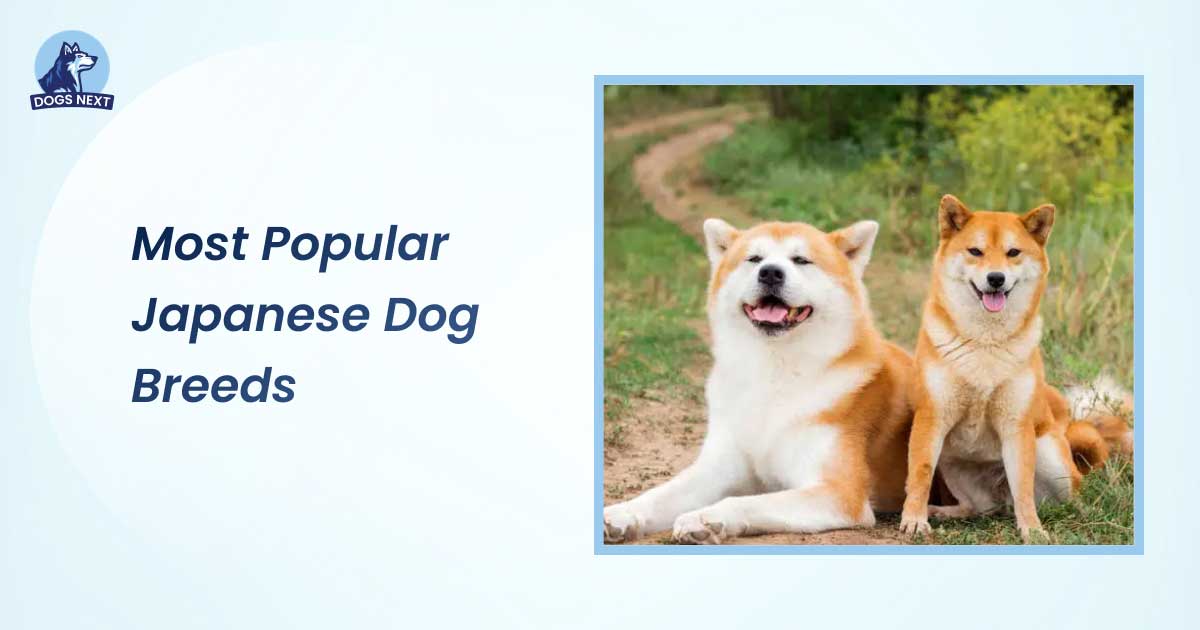The most popular Japanese dog breeds are Shiba Inu, Akita Inu, and Japanese Chin. These breeds are known for their loyalty and distinct appearances.
Japanese dog breeds have captured hearts worldwide. Shiba Inu, Akita Inu, and Japanese Chin are especially beloved. Shiba Inu, with its fox-like face and spirited personality, is a family favorite. Akita Inu is larger, known for its loyalty and courage, famously represented by Hachiko.
The Japanese Chin, a small and elegant breed, is cherished for its affectionate nature. Each breed has unique characteristics that appeal to different lifestyles. Whether for companionship or as a guard dog, these breeds offer a blend of tradition and love. Their popularity continues to grow, making them sought-after pets globally.
Shiba Inu: Japan’s Most Iconic Dog Breed
Japanese dog breeds are known for their unique characteristics and rich history. Among these, the Shiba Inu stands out as Japan’s most iconic dog breed. This breed captivates dog lovers worldwide with its spirited personality, fox-like appearance, and ancient roots. Below, we delve into the fascinating world of the Shiba Inu.
Origin And History Of The Shiba Inu
The Shiba Inu is one of the oldest and smallest Japanese heritage dogs. Their history dates back to 300 B.C., making them an integral part of Japan’s cultural fabric. Initially bred for hunting small game, these agile dogs navigated Japan’s rugged terrains with ease.
Key points about the Shiba Inu’s origin:
- Ancient Roots: The Shiba Inu is an ancient breed, existing for thousands of years.
- Hunting Skills: Originally used for hunting birds and small animals.
- Regional Variations: Different regions in Japan had their variations of the Shiba Inu.
A table highlighting key historical milestones:
| Year | Milestone |
|---|---|
| 300 B.C. | First known existence of Shiba Inu. |
| 1928 | Efforts to standardize the breed began. |
| 1936 | Declared a national treasure of Japan. |
These milestones emphasize the breed’s significance in Japanese culture and its enduring legacy.
Personality Traits And Why They’re So Popular
The Shiba Inu’s personality contributes greatly to its popularity. Known for being bold, independent, and loyal, they make excellent companions. Below are key personality traits and reasons for their widespread appeal:
- Bold and Confident: Shiba Inus are fearless and confident, often taking on challenges head-on.
- Independent Nature: They are known for their independence, which can sometimes be mistaken for aloofness.
- Loyal Companions: Despite their independence, they are incredibly loyal to their families.
These traits make Shiba Inus attractive to many dog enthusiasts. Their boldness and loyalty are particularly appealing.
Here are some Shiba Inu care tips to keep in mind:
- Provide regular exercise to keep them fit and happy.
- Brush their coat weekly to manage shedding.
- Socialize them early to prevent behavioral issues.
By understanding these traits and care tips, potential owners can better appreciate the Shiba Inu breed overview and ensure a happy, healthy life for their furry friends.
Akita Inu: The Loyal Companion
Japan is home to some of the most beloved dog breeds in the world. Among them, the Akita Inu stands out as a loyal companion. Known for its unwavering loyalty and strong personality, the Akita Inu has captured the hearts of many. This breed is not just a pet but a symbol of dedication and love in Japanese culture.
Story Of Hachiko In Japanese Culture
The story of Hachiko is one of the most famous Akita Inu stories. Hachiko, an Akita dog, waited for his owner every day at Shibuya Station in Tokyo. Even after his owner passed away, Hachiko continued to wait at the station for nearly 10 years. This incredible story of loyalty made Hachiko a national symbol of unwavering devotion.
Hachiko’s story has been told in books, movies, and even a statue at Shibuya Station. This statue is a popular meeting spot and a tribute to Hachiko’s remarkable loyalty. The tale of Hachiko showcases the Akita dog loyalty that is deeply embedded in Japanese culture.
Key points about Hachiko:
- Waited at Shibuya Station for 10 years
- Symbol of loyalty and devotion
- Honored with a statue at Shibuya Station
Hachiko’s story has inspired many to appreciate the loyalty and dedication of Akita Inus. This tale emphasizes why the Akita Inu is considered one of the most loyal breeds in the world.
Characteristics And Care Tips For Akitas
Akitas are known for their strong personalities and protective nature. Akita Inu personality traits include loyalty, bravery, and intelligence. They are excellent watchdogs and are always alert. Akitas are also very independent, which makes them unique among dog breeds.
Here are some essential Akita dog care guidelines:
- Exercise: Akitas need daily exercise to stay healthy. A long walk or a play session in the yard is ideal.
- Diet: A balanced diet is crucial. Ensure they get high-quality dog food rich in proteins.
- Grooming: Regular brushing is necessary to keep their coat clean. Akitas shed heavily twice a year.
- Training: Early training and socialization are important. Akitas are intelligent but can be stubborn.
Akitas are not for everyone. Their strong-willed nature requires an experienced owner. With proper care and training, Akitas can become the most loyal and loving companions.
Akitas are also known for their protective instincts. They are excellent with children but should be supervised due to their size and strength. Understanding Akita Inu personality traits can help in providing the best care for this remarkable breed.
Japanese Chin: The Royal Toy Breed
The Japanese Chin, often called the Royal Toy Breed, stands out among the most popular Japanese dog breeds. Known for their elegance and charm, these Japanese aristocratic dogs have a storied history and unique traits that make them ideal for many dog lovers. Let’s delve into the fascinating world of the Japanese Chin.
History Of The Japanese Chin
The Japanese Chin has a rich and intriguing history that dates back centuries. Originally bred as companion dogs for the Japanese nobility, these toy breeds of Japan were highly prized for their grace and beauty.
Some key points in their history include:
- Ancient Origins: Believed to have originated in China and brought to Japan as gifts to the Emperor.
- Royal Companionship: Exclusively kept by Japanese aristocrats, particularly in the Imperial Palace.
- Western Introduction: Introduced to the Western world in the 19th century, gaining popularity in both Europe and America.
In the table below, see a brief timeline of significant events in the history of the Japanese Chin:
| Year | Event |
|---|---|
| 8th Century | Introduction to Japan from China |
| 1853 | First introduction to the Western world by Commodore Perry |
| 1868 | Gained popularity in Europe and America |
Ideal For Small Spaces And Unique Traits
The Japanese Chin is perfect for apartment living or homes with limited space. These dogs are small, often weighing between 4 to 9 pounds, and have a calm demeanor that suits confined living environments.
Some Japanese Chin characteristics include:
- Size: Small and lightweight, perfect for carrying and cuddling.
- Temperament: Affectionate, intelligent, and easygoing, making them great companions.
- Appearance: Distinctive facial features with a flat face, large eyes, and a silky coat.
Japanese toy dog care is relatively simple:
- Grooming: Regular brushing to maintain their silky coat.
- Exercise: Moderate exercise needs, such as short walks or indoor play.
- Health: Regular vet check-ups to monitor common issues like respiratory problems due to their flat faces.
These unique traits and care requirements make the Japanese Chin a beloved pet for those who cherish elegance and companionship in a small package.
Kishu Ken: The Rare Hunting Dog
Japan is home to many unique dog breeds, each with its own rich history and characteristics. Among these, the Kishu Ken stands out as a rare hunting dog. This breed is known for its loyalty, intelligence, and hunting prowess. Despite its rarity, the Kishu Ken remains a beloved breed in Japan. Let’s delve into the background and reasons why this Japanese hunting dog breed is so special.
Background Of The Kishu Ken As A Hunting Breed
The Kishu Ken has a storied history as a hunting dog. Originating from the mountainous regions of the Kii Peninsula, this breed was developed for hunting game such as deer and wild boar. Known for its exceptional tracking ability, the Kishu Ken has an acute sense of smell and remarkable endurance.
Some key features of the Kishu Ken’s hunting background include:
- Silent Hunting: Unlike many other hunting breeds, the Kishu Ken hunts silently. This trait makes it highly effective in stalking prey without alerting them.
- Bravery: The Kishu Ken is fearless, often taking on large and dangerous game.
- Loyalty: These dogs are incredibly loyal to their owners, making them reliable hunting companions.
The Kishu Ken’s physical characteristics also support its hunting capabilities:
| Feature | Description |
|---|---|
| Size | Medium build, muscular |
| Coat | Short, dense, weather-resistant |
| Color | White, red, or brindle |
| Temperament | Calm, determined, alert |
These qualities make the Kishu Ken not only an excellent hunting dog but also a loyal companion.
Why The Kishu Ken Remains A Rare But Beloved Breed In Japan
The Kishu Ken rarity stems from several factors. Firstly, the breed is highly localized, with most Kishu Kens found in specific regions of Japan. This limited geographical distribution contributes to its rarity.
Several factors contribute to the Kishu Ken’s beloved status in Japan:
- Historical Significance: The Kishu Ken has a rich cultural heritage. It is considered a national treasure and is protected by Japanese law.
- Unique Characteristics: The Kishu Ken’s hunting instincts and loyalty make it a highly valued pet and working dog.
- Breed Maintenance: Maintaining the purity of the breed is crucial. Breeders are selective, ensuring that the Kishu Ken retains its unique traits.
Despite its rarity, the Kishu Ken continues to be cherished by those who own them. Their strong hunting instincts, coupled with their calm and loyal nature, make them ideal pets for those who appreciate their unique qualities.
In summary, the Kishu Ken’s rarity and beloved status can be attributed to its historical significance, unique characteristics, and careful breed maintenance. This makes it a treasured part of Japan’s canine heritage.
Shikoku: The Spirited Mountain Dog
Japan is home to some of the most unique and beloved dog breeds in the world. Among these, the Shikoku: The Spirited Mountain Dog stands out for its agility, loyalty, and spirited nature. Known for its rich history and exceptional traits, the Shikoku dog captures the heart of dog lovers everywhere.
Origin In Japan’s Shikoku Island
The Shikoku breed has its roots in the rugged terrain of Japan’s Shikoku Island. This island, known for its mountainous landscape, is the perfect backdrop for this agile and resilient breed. The Shikoku was originally bred for hunting in these challenging environments, making it a true Japanese mountain dog.
The Shikoku breed history dates back centuries, with these dogs traditionally used to hunt boar and deer. Their keen senses and agility made them invaluable to hunters in the region. The breed is also known as the Kochi-ken, named after the Kochi Prefecture on Shikoku Island where they were predominantly found.
Here are some key points about the origin of the Shikoku:
- Region: Shikoku Island, Japan
- Traditional Use: Hunting boar and deer
- Other Names: Kochi-ken
- Characteristics: Agility, keen senses, resilience
The breed’s history is rich with tales of bravery and loyalty, making the Shikoku a cherished part of Japan’s cultural heritage. The breed’s resilience and adaptability have allowed it to thrive in various environments, from dense forests to open fields.
Temperament And Care Needs Of The Shikoku Breed
The Shikoku dog behavior is marked by its spirited and loyal nature. These dogs are known for their intelligence and independence, making them both challenging and rewarding pets. They form strong bonds with their families and are often wary of strangers, displaying a protective instinct.
The Shikoku breed care requires understanding their high energy levels and need for regular exercise. These dogs thrive in environments where they can run and explore, mirroring their natural hunting instincts. A daily routine should include:
- Exercise: At least one hour of vigorous activity
- Mental Stimulation: Engaging games and training sessions
- Socialization: Regular interaction with other dogs and people
Proper grooming is also essential for the Shikoku. Their coat, which is dense and weather-resistant, needs regular brushing to keep it healthy. Bathing should be done as needed, and regular check-ups with a veterinarian ensure they stay in optimal health.
Here’s a brief overview of their care needs:
| Aspect | Requirement |
|---|---|
| Exercise | High – daily vigorous activity |
| Grooming | Moderate – regular brushing, occasional bathing |
| Socialization | High – needs interaction with other dogs and people |
| Mental Stimulation | High – engaging activities and training |
Understanding the Shikoku’s temperament and care needs ensures a happy, healthy life for these spirited mountain dogs. Their loyalty and unique traits make them a rewarding companion for those who can meet their needs.
Tosa Inu: Japan’s Mastiff
Japan is home to many unique dog breeds, each with its own history and charm. Among them, the Tosa Inu, also known as Japan’s Mastiff, stands out for its strength and loyalty. This large breed has a fascinating past and requires special care. Let’s dive into the world of the Tosa Inu.
History Of The Tosa Inu Fighting Dog
The Tosa Inu originated in the late 19th century in Japan. It was bred in Tosa, now known as Kochi Prefecture. The breed was developed by crossing native Shikoku fighting dogs with Western breeds like Mastiffs, Bulldogs, and Great Danes. This combination created a powerful and resilient breed.
The Tosa Inu was primarily used as a fighting dog. In Japan, dog fighting was a popular sport, and breeders aimed to create a dog that excelled in combat. The Tosa Inu’s strength, endurance, and courage made it a favorite in the ring. Despite its fierce reputation, the Tosa Inu is known for its calm demeanor outside the fighting arena.
Here are some key points about the Tosa Inu fighting history:
- The breed was a symbol of bravery and honor.
- It was often referred to as the “Sumo wrestler” of the dog world.
- Dog fighting was regulated in Japan, and the Tosa Inu was bred to follow strict rules.
Today, dog fighting is illegal in many parts of the world. The Tosa Inu is now appreciated for its loyalty and protective nature. It remains one of the most large Japanese dog breeds.
Responsible Ownership And Care Of This Large Breed
Owning a Tosa Inu requires dedication and knowledge. This large breed needs proper care to thrive. Here are some Tosa Inu training tips and care guidelines:
Training:
- Start training early to establish good behavior.
- Use positive reinforcement techniques.
- Socialize the Tosa Inu with other dogs and people.
Exercise:
- Provide at least 1-2 hours of exercise daily.
- Engage in activities like walking, running, and playing fetch.
- Avoid overexertion, especially in hot weather.
Diet:
- Feed high-quality dog food suitable for large breeds.
- Monitor portion sizes to prevent obesity.
- Ensure access to fresh water at all times.
Health Care:
Regular veterinary check-ups are crucial. Be aware of common health issues in large breeds, such as hip dysplasia and bloat. Here are some Tosa Inu health care tips:
- Schedule annual vet visits.
- Maintain a proper vaccination schedule.
- Brush their coat weekly to keep it healthy.
- Check ears and clean them regularly to prevent infections.
Responsible ownership of a Tosa Inu ensures a happy and healthy dog. This magnificent breed can be a loyal companion with the right care and training.
Frequently Asked Questions
What Are The Most Popular Japanese Dog Breeds?
The most popular Japanese dog breeds include Shiba Inu, Akita Inu, and Japanese Chin. These breeds are known for their loyalty and unique appearance.
Are Shiba Inus Good Family Pets?
Yes, Shiba Inus can be good family pets. They are loyal, alert, and independent. Proper training and socialization are key.
How Big Do Akita Inus Get?
Akita Inus are large dogs. Males can weigh up to 130 pounds. Females are slightly smaller, weighing up to 110 pounds.
What Is The Temperament Of A Japanese Chin?
Japanese Chins are affectionate, intelligent, and playful. They are great companion dogs and adapt well to living in apartments.
Conclusion
Japanese dog breeds offer unique traits and loyal companionship. Each breed has its distinct charm and history. Choosing the right dog depends on lifestyle and preferences. Explore these breeds to find a perfect furry friend. Embrace the joy and culture that comes with owning a Japanese dog.
Happy pet hunting!

I’m David, an expert contributor and writer, with two furry friends of my own, I know the challenges of raising and caring for dogs. From training to nutrition and health, my goal is to provide valuable insights and advice to help create strong bonds and happy, healthy lives. Find me in Twitter.


